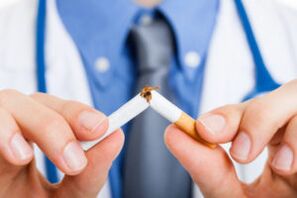
Often, heavy smokers are faced with a deterioration in health: they notice the appearance of a cough with phlegm, shortness of breath, disruptions in the work of the heart. In addition, smoking has a negative effect on appearance: the teeth turn yellow, the complexion becomes dull and the skin becomes dry. Therefore, almost all smokers have tried at least once to give up the bad habit.
However, instead of feeling better right away, many people find that they have literally hurt everything after smoking their last cigarette. As a result, a person goes back to smoking, choosing, as it seems to him, the lesser of evils.
Let's see why some unpleasant symptoms can appear with a clear refusal of cigarettes? What to do if a person stops smoking but has health problems?
Processes in the body after quitting smoking
Each of the smokers who decide to quit smoking must understand that their addiction to tobacco is not only psychological, but also physiological. Nicotine in the literal sense of the word is included in the body's metabolism. Therefore, the reason one does not feel well when quitting smoking is a condition similar to drug withdrawal. The fact that a person, linked to an addiction, has started to get sick, suggests that the body is rebuilding itself to function without the participation of nicotine.
In addition, it should be understood that these health problems are temporary and will cease to disturb once the adjustment period has elapsed. In other words, someone who is determined to quit smoking should be patient and get through this period during which he will experience unpleasant symptoms.
Important!In fairness, it should be noted that not all smokers of yesterday face pronounced problems. Someone has a very strong withdrawal syndrome, while others simply and easily give up cigarettes.
Gastrointestinal tract
The gastrointestinal tract disorder is noticed by one in two people who quit smoking. Most often, in this case, people notice that they have an upset stomach, since against the background of the refusal of cigarettes, a decrease in intestinal tone may appear. As a result, increased gas production and constipation begin to worry.
The situation is no less common when a person has stopped smoking and is sick. Heartburn often appears after quitting smoking. The reason for such symptoms is the action of tobacco smoke, which, entering the stomach, irritates its walls and causes the appearance of gastritis.
However, while a person continues to smoke, nicotine to some extent has an antispasmodic effect and reduces pain. When the intake of an alkaloid into the body stops, gastric juice with an increase in the level of acidity irritates the mucous membrane, causing heartburn, nausea and pain.
Also, if a person has stopped smoking and noticed that their stomach has started to ache, the reason may be a stomach or duodenal ulcer formed during addiction. This is a serious disease that requires the supervision of a gastroenterologist. Therefore, if a patient stops smoking and notices heartburn, nausea and belching, constipation and abdominal pain, she should seek specialist help as soon as possible.
Skin problems
Many smokers of yesterday notice pimples on their face and back after they quit smoking. There can be several reasons that explain this phenomenon:
- Changes in vascular tone. During the active effect of nicotine on the body, the smoker's skin becomes dry and the small vessels that feed it are in a spasmodic state. When quitting smoking, the opposite process can be observed - an increase in oily skin. The high level of sebum production, in turn, is a great background for acne formation;
- If a person quits smoking and has acne, this may indicate a hormonal imbalance, which can also occur in the body against the background of nicotine neglect. It must be remembered that quitting smoking is stress for the body, which can affect all its organs and systems;
- Pimples after smoking can form due to a trivial exacerbation of acne for the same reason: a stressful situation in which the body finds itself during the restructuring to a new mode of functioning;
- Finally, the appearance of skin problems can be explained by the fact that, giving up a bad habit, a person is so exhausted from the struggle with the desire to smoke that he simply does not have the strength to care for the skin. As a result, acne on the face is formed due to trivial violations of hygiene rules, especially if the skin is initially predisposed to the appearance of such problems.

Throat and oral cavity
The common complaints of those who decide to quit smoking are also sore throats and "scratches" in the throat. For example, consider a situation: a woman quits smoking and notices that her throat has started to hurt. If you previously managed to stifle these symptoms with a cigarette, then with a high degree of probability the smoker will return to cigarettes. In the meantime, it should be understood that a sore throat is also a temporary phenomenon, caused by the process of clearing the airways or the exacerbation of a chronic infection against the background of nicotine rejection.
Another problem of yesterday's smokers is gum bleeding. Sometimes the process is so pronounced that after refusing a cigarette, the teeth hurt and become less resistant.
The main reason why a person who decides to quit smoking has bleeding gums, stomatitis or loose teeth is a decrease in immunity against the background of nicotine rejection. It becomes difficult for a weakened body to resist gingivitis and tooth decay, which were formed during the period of tobacco addiction.
Joint and back pain, varicose veins
Yesterday smokers often have a feeling of stiffness in the back and joint pain. It would seem that there can be no link between quitting smoking and the fact that, for example, a bad back. However, the appearance of such symptoms can have several explanations at the same time.
If a person stops smoking and her legs hurt, this may indicate a manifestation of the so-called drug withdrawal. It is no secret that nicotine has the effect of a weak drug, therefore, when it stops entering the body, it is quite possible for phantom pains to appear throughout the body.
Attention!Another explanation for the fact that a smoker has joint pain after quitting a bad habit is the exacerbation of chronic diseases (arthritis, osteoarthritis) in a stressful situation for the body. In this regard, if the legs hurt a lot after smoking and the joint pain does not go away within a few days, you should seek the help of a doctor.
Other side effects after quitting smoking
The symptoms listed are not a complete list of the problems a person may face when deciding to get rid of a bad habit. Almost all former smokers during the first days of quitting smoking notice weakness, weakness, general malaise.

Without cigarettes, addicts become nervous and irritable. It is not surprising that many of them do not withstand such a test and soon break, lighting a cigarette again.
Normalization period
However, those who have been able to endure the difficult first period after quitting smoking soon notice an improvement in their well-being. The phenomena of the so-called withdrawal usually disappear by the end of the first week. Within a month, the work of the gastrointestinal tract and blood vessels is restored. The skin stops being dry and bad breath disappears.
Complete normalization of the state of most former smokers usually occurs no later than six months after they have completely stopped smoking.
Conclusion
Despite the fact that it can be very difficult to quit a bad habit, usually none of the people who quit smoking regret their decision. Smoking really causes significant damage to the body, so when you stop consuming nicotine, people actually get healthier, feel better and look better.























